| | | | |  | |  | | | |
The Great Flood 1930
The most disastrous flood New Mills has ever known occurred in June, 1930, resulting in loss of life, damage to property and great hardship. There had been very heavy thunder, lightening and torrential rain in the area for some time before noon. Some houses were being flooded on Hayfield road and other places at that time, but the cause of the flood appears to have been a cloudburst in the direction of Rowarth. It was shortly after noon that the river seemed to rise suddenly and overflow its banks. It was later estimated that River Sett rose by over twenty feet on its way through New Mills.

In the area around the old New Mills Bridge at the bottom of High street, where the rivers course is suddenly narrowed, the waters become concentrated. Rising rapidly by many feet; the Windsor Castle lodging house (below Dyehouse Lane), Salem Cottages and the cottages known as Brookside were all flooded. The people for the most part saw the water rising and made their escape. In Salem Cottages, however, some were left behind including children. Constable Millward went to the scene and rendered heroic service. Two young men, Albert Edwards and James Jennings, worked hard in the rescue work using ladders to rescue some of the children, and even then Constable Millward had to swim to bring some to safety. His splendid work was warmly commended. Many brave feats were performed in the rescues from Salem Cottages. This is how it was described by James Jennings ‘we saw the family frantic at the top window in the last cottage when the water had risen some twelve feet. Some pals and myself went into the water down the slope from High Street. Albert Edwards, of Dyehouse lane swam with a ladder and placed it against the window. Sydney Dawson, from High Lea, went up the ladder and smashed the window and handed the three children to Johnny Burgess and myself. We worked with the water up to our chins, handing the youngsters over with one hand while we clung to the ladder with the other. Albert first bought Thomas Berry (aged 9) and then Irene Berry (6) to safety by tucking them under one arm with their heads above water and swimming with the other arm. Constable Millward took off his helmet and tunic and swam to the ladder carrying Clara Berry (3) away, using the backstroke. Once the current took him under, but he came up in a second and made his way to the bank. Lastly, Mrs. Berry was bought out of the house.’
Constable Millward was exceedingly modest about his part in this work, and declined to say anything about it. An eyewitness described the scene: ‘Constable Millward never hesitated when he saw what was happening to the family. He at once took off his tunic and helmet and dived into the water and swam to the back of the houses. When he reached the bedroom window he got on his back, and managed somehow to get the child on his breast. On his back he swam to the bank with the child on his breast, and landed the child safely- a truly noble and brave deed in such a torrent and with so much debris coming down.’
Across the river from the Salem Cottages and mill, below Dyehouse Lane stood the Windsor Castle lodging house. One of the inmates at the lodging house at the time of the flood was Mr Thomas Gannon, a one armed man, who earned his living as a pedlar. He was washed away in the flood. Another man at the lodging house, Mr Frank Devlin, made a brave attempt to rescue him. Frank later told his own story ‘I 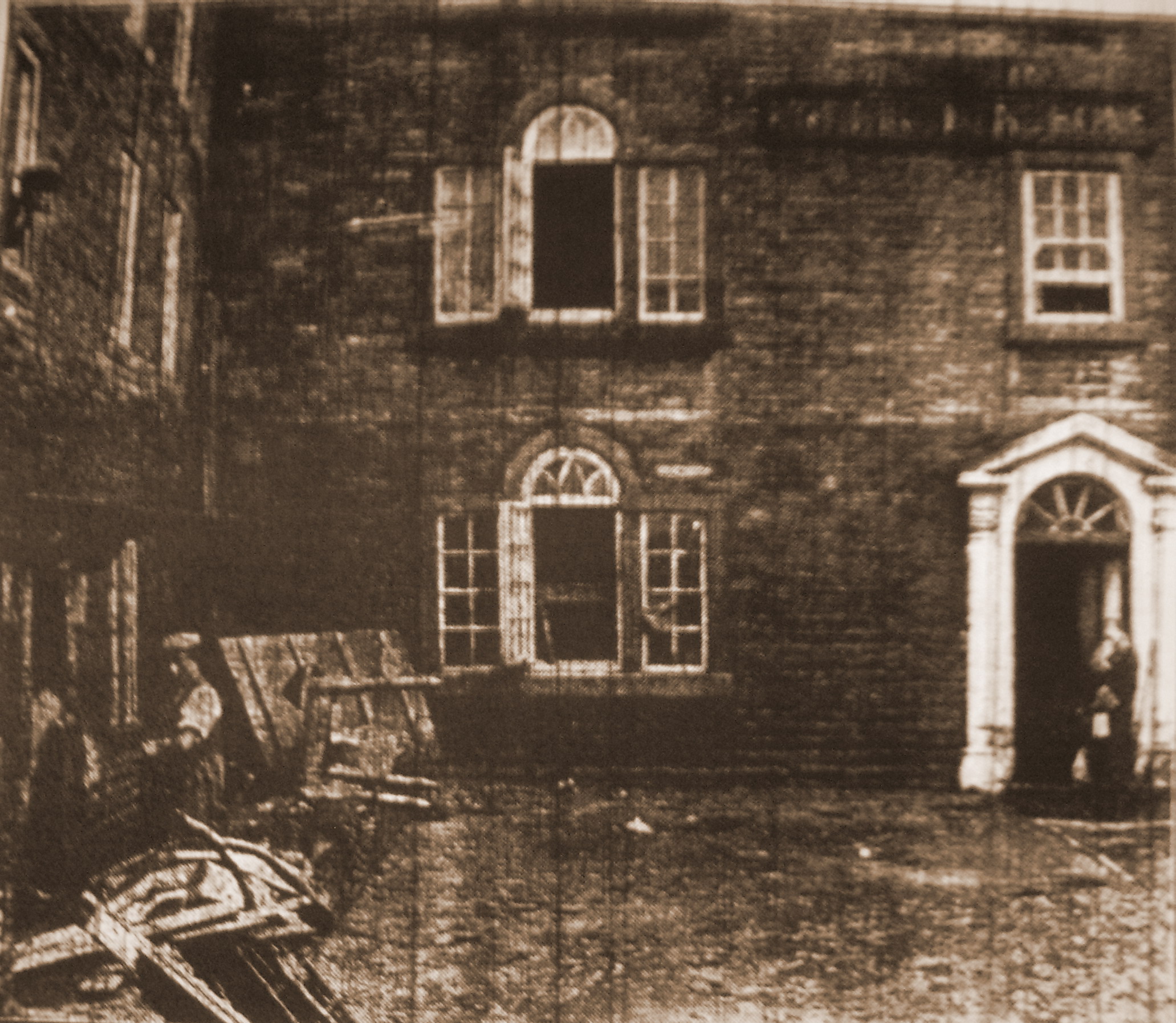 was in the kitchen with Mr and Mrs. Gannon, watching the storm, when I saw a wall of water at least fourteen feet high sweeping toward the window. It poured through the window as if it were a weir. I grabbed hold of Mrs. Gannon round the waist and waded with her in water up to our necks and set her on the stairs, up which she scrambled. I returned to help Mr Gannon. He was holding onto the window casement like grim death, trying to keep his head above the water. I caught hold of him by the shoulder and tried to get him to step onto the table in front of the window. Apparently he had lost his nerve for he would not budge. I stuck to him till the flood was six inches from the ceiling, and then the current snatched him out of my grasp. He was struggling for about a minute in the racing waters, his hand went up. I never saw him again. I had just time to swim across the kitchen and dive under the water up the stairs. If he had gone up the stairs he might have had a chance of being saved.’ was in the kitchen with Mr and Mrs. Gannon, watching the storm, when I saw a wall of water at least fourteen feet high sweeping toward the window. It poured through the window as if it were a weir. I grabbed hold of Mrs. Gannon round the waist and waded with her in water up to our necks and set her on the stairs, up which she scrambled. I returned to help Mr Gannon. He was holding onto the window casement like grim death, trying to keep his head above the water. I caught hold of him by the shoulder and tried to get him to step onto the table in front of the window. Apparently he had lost his nerve for he would not budge. I stuck to him till the flood was six inches from the ceiling, and then the current snatched him out of my grasp. He was struggling for about a minute in the racing waters, his hand went up. I never saw him again. I had just time to swim across the kitchen and dive under the water up the stairs. If he had gone up the stairs he might have had a chance of being saved.’
Mr Devlin was a brave man. Some years previously he had rescued two men from the North road reservoir at Glossop. For which action he had been awarded the Royal Humane Society’s medal. Great regret was expressed at the fate of Mr Gannon. He was a familiar figure in New Mills. A police search later recovered his body near Waterside Road, at Hague Bar.
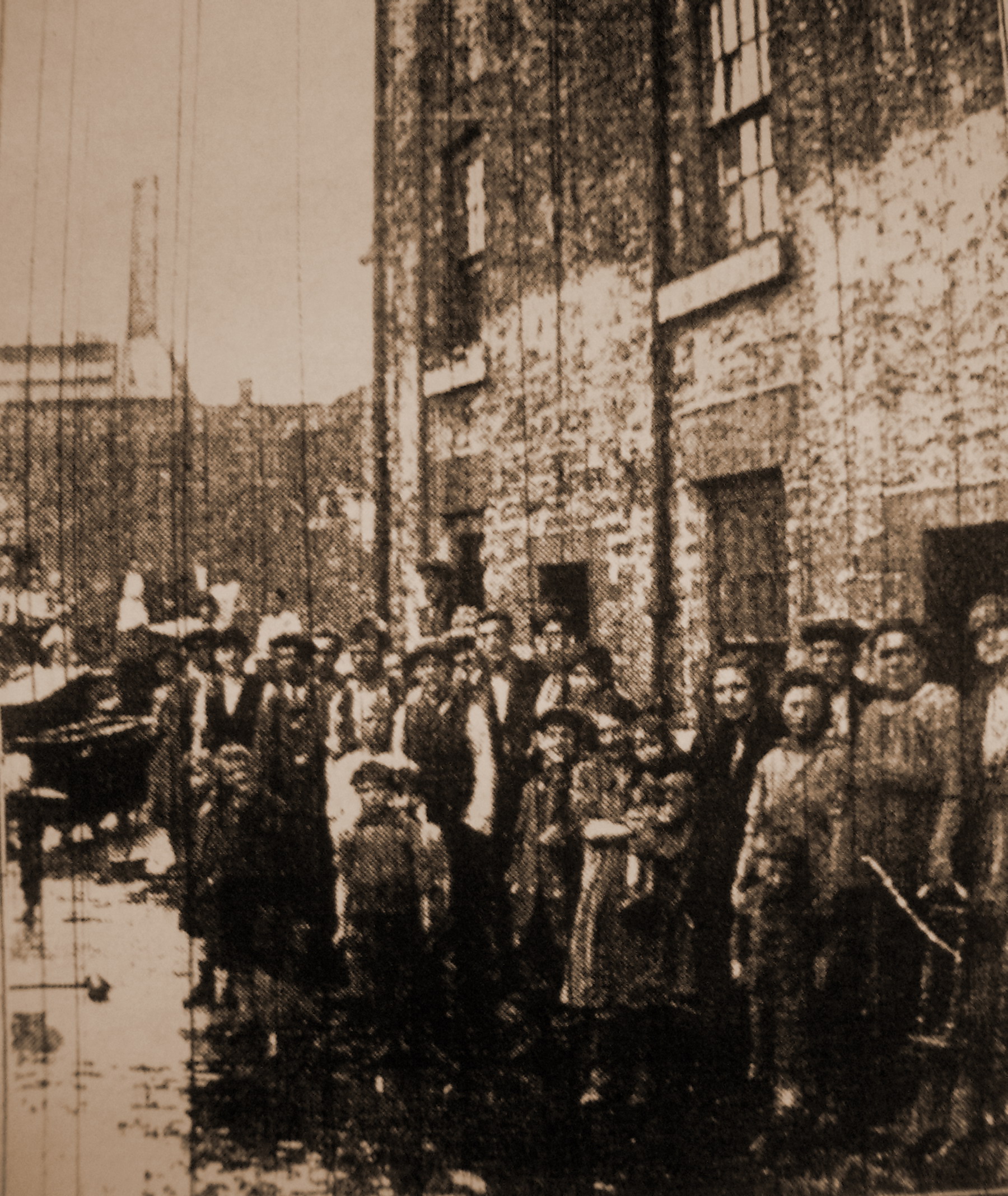 The water reached the second storeys of the houses at Brookside. The residents were able to leave for places of safety, but there was not time to remove the furniture. When the waters had subsided it was pitiable to see the furniture almost ruined, and the clothing and other articles that they had contained saturated. This area of the town had only recently been condemned in a medical officer’s report. That report was not to be acted on for another twenty years. The water reached the second storeys of the houses at Brookside. The residents were able to leave for places of safety, but there was not time to remove the furniture. When the waters had subsided it was pitiable to see the furniture almost ruined, and the clothing and other articles that they had contained saturated. This area of the town had only recently been condemned in a medical officer’s report. That report was not to be acted on for another twenty years.
Some of the parapet of the old bridge at the bottom of High street had been washed away by the flood, and this caused a greater volume of water to flow into the already flooded houses at Brookside. One part of the bridge has a small stone arch, but this was soon blocked with debris, and was useless for carrying the immense volume of water coming down the river. Another portion of the bridge has iron girders, but the span here was soon useless. To add to the trouble the culvert which brings water down from the region near the railway line was burst. Water was pouring into Hyde Bank road from there also. So that Hyde bank road was impassable and the houses flooded. Indeed Hyde Bank road was the River Sett to all intents and purpose at that time. A big hole was torn into the road by the bursting of the culvert and the road remained impassable long after the waters had fallen.
The first works on the Hyde Bank roadside of the old bridge are those of Messrs. Arnfield, iron founders and engineers. Access to the works yard was by an iron girder bridge and abutting the bridge were the offices. One of the girders collapsed owing to the tremendous force of the water and bought some of the front portion of the offices with it, allowing the waters in. Some of the staff at work in the drawing office on the second floor were endangered by the flood, for more of the building might have collapsed in the still rising waters. The staff were forced to make their exit by a skylight on the roof. From there a ladder was thrown across to a garage and from there they got to safety amid much excitement. The bridge was not sufficiently high to allow the waters to pass under and the yard and then the works were flooded. Another building of corrugated iron standing on iron girders over the river, collapsed as the girders were dislodged. This pulled down a part of the stone building near it. The staff at Messrs Arnfield had resumed work after dinner, when they noticed the river was rising and they got out before the collapse occurred. Some of them had to wade through the water and it was almost a miracle there were no casualties.
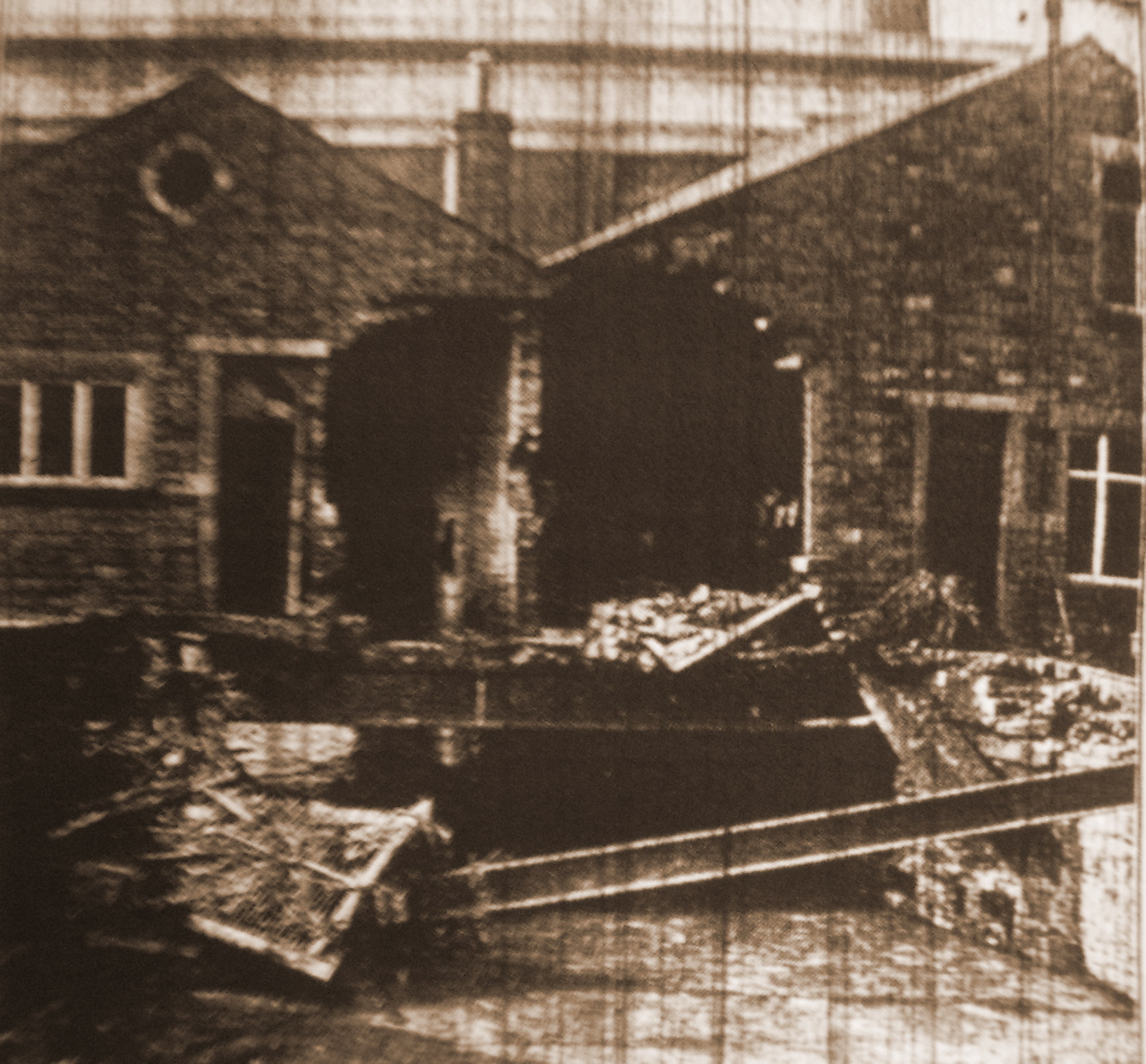 In another part of the works huge iron plates weighing many cwts. had been dislodged, the force behind the waters must have been tremendous. Much damage was done in the building that collapsed, and it is stated that many of the men lost their tools which they had not time to collect as they made their hurried escape. Mr Harry Roberts related how the men heard the rushing of the water while at work. ‘It was so suddenly up to our knees and swirling round us, we managed to get out of the room and into the yard and climb up the bank.’ About seventy men were thrown out of work for over two months as a result of the damage at the foundry. In another part of the works huge iron plates weighing many cwts. had been dislodged, the force behind the waters must have been tremendous. Much damage was done in the building that collapsed, and it is stated that many of the men lost their tools which they had not time to collect as they made their hurried escape. Mr Harry Roberts related how the men heard the rushing of the water while at work. ‘It was so suddenly up to our knees and swirling round us, we managed to get out of the room and into the yard and climb up the bank.’ About seventy men were thrown out of work for over two months as a result of the damage at the foundry.
Next to Messrs Arnfield’s foundry is the Beard Mill. This also was flooded in the lower rooms, but happily there was no collapse of any buildings although the water runs beneath an arch under the mill. Visible from the bridge at the bottom of Church road is the old and narrow bridge in the Torrs, which led the way to the old Torr mill complex which was destroyed by fire some twenty years previous. The parapet of the bridge was washed away but the arch remained intact. Some damage was also done to the old stables in the Torrs.
Sheep and cattle were seen floating through the Torrs on the roaring waters, hencotes, branches, uprooted trees and all manner of other debris. The point at which the rivers Sett and Goyt converge was a mighty cauldron of boiling seething power. No sight could be seen of the big weir.
No one who saw the scene at the bottom of New Mills was ever likely to forget it. And hundreds saw it. News of the disaster spread like wildfire, works were closed, and crowds of people were soon on the spot. The road was deep with mud, but the people waded through it to see the damage. The river continued high for some hours and the muddy waters swirled along carrying debris by the ton. But the most affecting scenes were the poor folks who were rendered practically homeless. They were able about four o’clock to get their furniture into the road, and to try to calculate the damage that had been done, and to endeavour to make some provision for themselves. It was a heart-breaking scene. Local people rallied round to provide a relief fund.

Meanwhile a tragedy had occurred upstream at the hamlet of Rowarth. The waters at Rowarth rose very rapidly in the downpour, tearing past the Little Mill Inn and it was here the tragedy occurred. Mr John Ollerenshaw the landlord and others were attempting to hold back the flood. An impossible task, as the water rose up the stairway, the customers and staff sought refuge in the upper rooms. Mr Ollerenshaw was endeavouring to get from one door to the other around the house, when he was caught in the flood and swept away. His body was later recovered from the stream near Bate Mill Bleachworks, a mile from the Inn. Mrs Ollerenshaw was a tragic witness of the fate of her husband; she said ‘it was so sudden I could do nothing. One moment he was standing outside trying to sweep the water back from the door and the next a sudden burst of water caught him and forced him onto his knees. I saw him look up at the house and raise a hand and a second later he was caught by the water and swept away into the river. It was impossible to do anything in the swirling torrent of water, and by the time we got out of the house my husband had disappeared.’ Mrs Ollerenshaw’s nephew was with her in the house at the time and had to restrain his aunt from going outside to help her husband. They were eventually rescued from the back window of the Inn. Much damage was done at Rowarth, cattle and sheep, hencotes and poultry, trees and bridges were all swept away. The corner of the Little Mill was undermined and washed away. Similar damage was done at Aspenshaw with cottages flooded and anything in the waters course uprooted at carried away. A child was also rescued from the flood here.
The scene at Watford Bridge was described as remarkable. The river bed was not wide enough to take the roaring torrent. The windows on the printworks were smashed by the force of water and debris and the rooms flooded to a depth of many feet. The road walls were smashed down and the footpath and road ways obliterated. The four houses at the bottom of Bridge street were badly flooded. At Bate Mill the damage was even worse. Here the waters came roaring down from Rowarth. The stream under ordinary conditions goes beneath the bridge near the works boiler house. But it tore a way of its own on the Thornsett side of the works, washed down the wall and went down the fields. The works sewage beds were washed away entirely and no trace of them remained. Near the sewage beds were stored two hundred and fifty tons of coal belonging to Bate Mill bleachworks. The whole of it was washed away. The road was narrowed to a few feet and impassable and the gas main broken. Two houses at Higher Noon Sun were flooded, but those at Lower Noon Sun had the worst of it. These houses abut the roadway. The occupants closed their doors and went into the bedrooms to escape the flood. This prevented the flow of water and the houses were soon filled with water. Luckily some men engaged on laying a new gas main saw the predicament of the residents. With sledge hammers they smashed open the doors and with the use of ladders succeeded in rescuing the residents.Without their prompt action there would certainly have been an increase in the number of casualties.
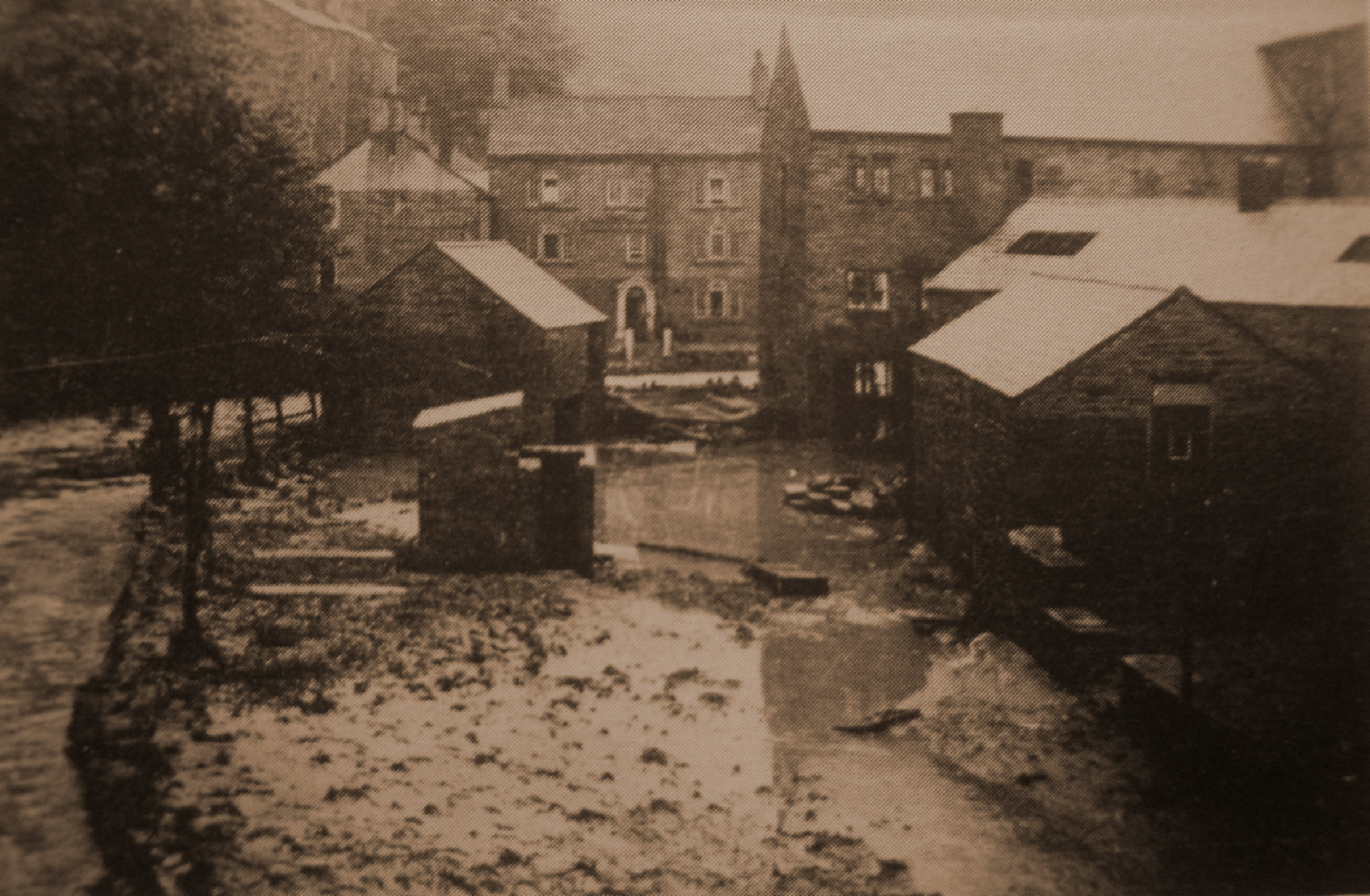
In Birch Vale district the full force of the storm was felt. Water poured from Lantern Pike like a huge river and made a magnificent spectacle. It flowed down the hillside and through the yard at Lower Cliff Farm, and down the fields into the river Sett, on the Hayfield side of Birch Vale Printworks. The Garrison Bleachworks, a little further down the river was more in the storm area. Water poured down by the ‘16 row’ into the road dislodged a portion of the boundary wall of the road and flooded into the works yard. Some of the works were flooded. The goit that carried the water for cooling the engines was blocked by debris and that bought the works to a standstill.
By one o’clock the culvert near Ravensleach at Birch Vale, had become entirely inadequate to carry the volume of water coming down the side of the hill. The road was badly flooded and water ran along it to the houses near the Vine Tavern. The people there made brave efforts to keep it out of the houses, but did not entirely succeed. Houses on both sides of the road suffered. The road which runs alongside Birch Vale cricket field was turned into a raging torrent. It ran across the road and down the lane leading to Garrison bleachworks. A considerable portion of the wall at Lowleighton was washed down, and so was a part of the wall at Ravensleach. A reservoir was made in the field at Lowleighton, opposite the turn to High Hill and here a hencotes was seen floating with a man on top of it endeavouring to rescue the poultry from inside it. Another river was made down the lane from Morlands at Birch Vale causing considerable damage both at the Grouse and at Spinnerbottom.
There is still much evidence of the flood to be seen today as many of the walls in the district contain section of railings. These were put in place where section of wall were washed down or had to be broken down to disperse the flood.
 
The Great Flood of June 1872.


 |
| | ![]() |  | |  | | | | | |
|
|







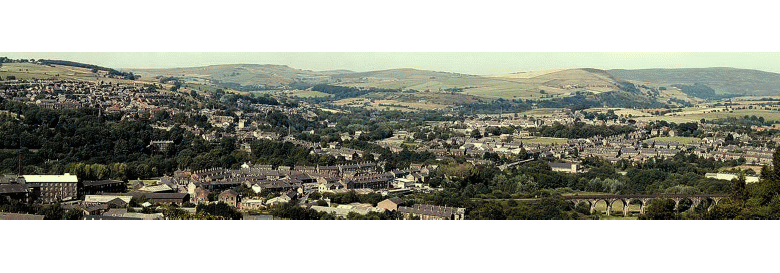


 was in the kitchen with Mr and Mrs. Gannon, watching the storm, when I saw a wall of water at least fourteen feet high sweeping toward the window. It poured through the window as if it were a weir. I grabbed hold of Mrs. Gannon round the waist and waded with her in water up to our necks and set her on the stairs, up which she scrambled. I returned to help Mr Gannon. He was holding onto the window casement like grim death, trying to keep his head above the water. I caught hold of him by the shoulder and tried to get him to step onto the table in front of the window. Apparently he had lost his nerve for he would not budge. I stuck to him till the flood was six inches from the ceiling, and then the current snatched him out of my grasp. He was struggling for about a minute in the racing waters, his hand went up. I never saw him again. I had just time to swim across the kitchen and dive under the water up the stairs. If he had gone up the stairs he might have had a chance of being saved.’
was in the kitchen with Mr and Mrs. Gannon, watching the storm, when I saw a wall of water at least fourteen feet high sweeping toward the window. It poured through the window as if it were a weir. I grabbed hold of Mrs. Gannon round the waist and waded with her in water up to our necks and set her on the stairs, up which she scrambled. I returned to help Mr Gannon. He was holding onto the window casement like grim death, trying to keep his head above the water. I caught hold of him by the shoulder and tried to get him to step onto the table in front of the window. Apparently he had lost his nerve for he would not budge. I stuck to him till the flood was six inches from the ceiling, and then the current snatched him out of my grasp. He was struggling for about a minute in the racing waters, his hand went up. I never saw him again. I had just time to swim across the kitchen and dive under the water up the stairs. If he had gone up the stairs he might have had a chance of being saved.’ The water reached the second storeys of the houses at Brookside. The residents were able to leave for places of safety, but there was not time to remove the furniture. When the waters had subsided it was pitiable to see the furniture almost ruined, and the clothing and other articles that they had contained saturated. This area of the town had only recently been condemned in a medical officer’s report. That report was not to be acted on for another twenty years.
The water reached the second storeys of the houses at Brookside. The residents were able to leave for places of safety, but there was not time to remove the furniture. When the waters had subsided it was pitiable to see the furniture almost ruined, and the clothing and other articles that they had contained saturated. This area of the town had only recently been condemned in a medical officer’s report. That report was not to be acted on for another twenty years. In another part of the works huge iron plates weighing many cwts. had been dislodged, the force behind the waters must have been tremendous. Much damage was done in the building that collapsed, and it is stated that many of the men lost their tools which they had not time to collect as they made their hurried escape. Mr Harry Roberts related how the men heard the rushing of the water while at work. ‘It was so suddenly up to our knees and swirling round us, we managed to get out of the room and into the yard and climb up the bank.’ About seventy men were thrown out of work for over two months as a result of the damage at the foundry.
In another part of the works huge iron plates weighing many cwts. had been dislodged, the force behind the waters must have been tremendous. Much damage was done in the building that collapsed, and it is stated that many of the men lost their tools which they had not time to collect as they made their hurried escape. Mr Harry Roberts related how the men heard the rushing of the water while at work. ‘It was so suddenly up to our knees and swirling round us, we managed to get out of the room and into the yard and climb up the bank.’ About seventy men were thrown out of work for over two months as a result of the damage at the foundry.




